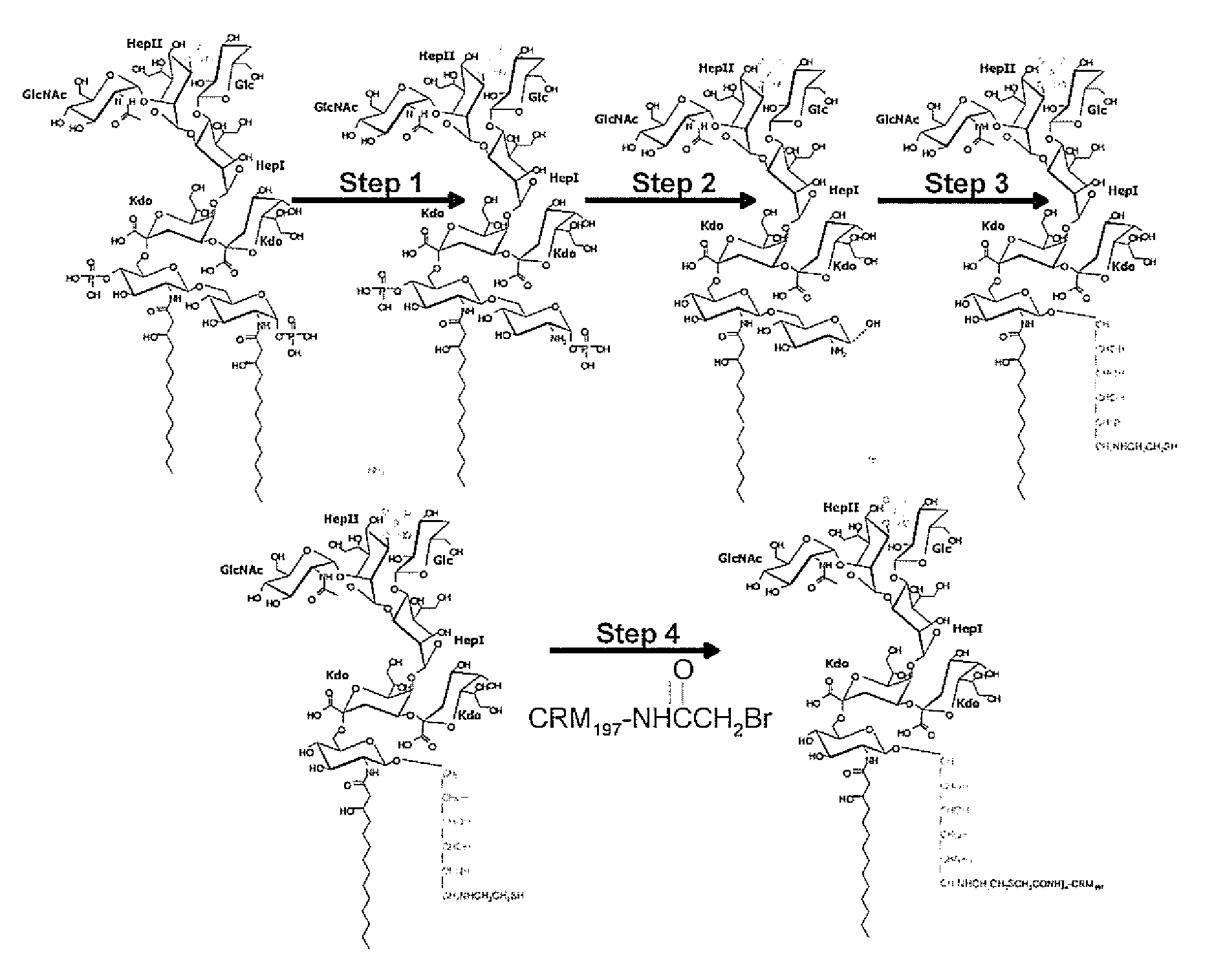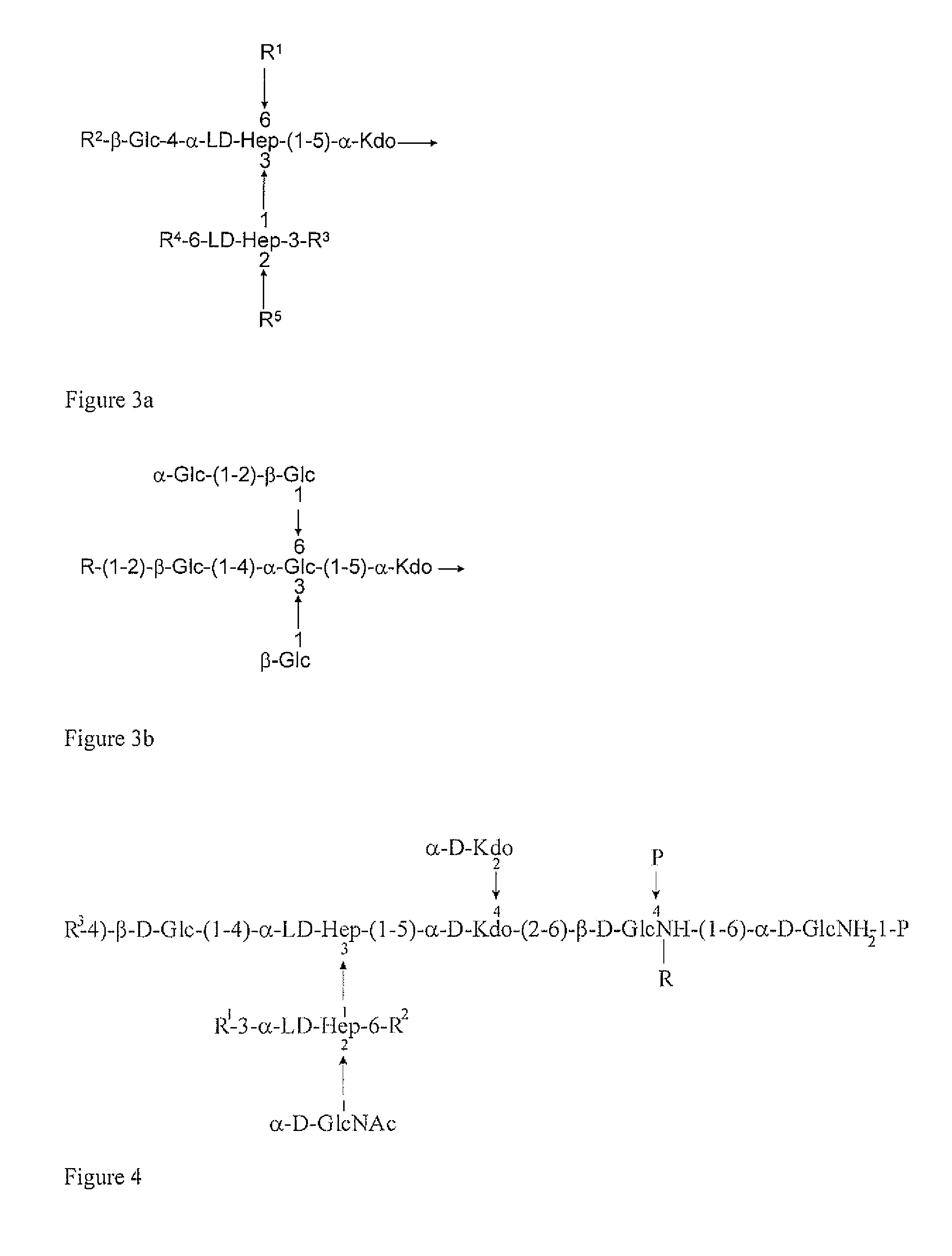LPS Based Vaccines
a technology of lps and vaccines, applied in the field of lps based vaccines, can solve the problems of poor immunogenicity, difficult detection of conserved molecules that would confer protection against the vast majority of strains of a single species, and poor o-antigens
- Summary
- Abstract
- Description
- Claims
- Application Information
AI Technical Summary
Benefits of technology
Problems solved by technology
Method used
Image
Examples
example 1
Identification of Open Chain Neo-Epitope
[0166]In previous studies using Neisseria meningitidis serogroup B (NmB) glycoconjugates prepared from O-deacylated lipopolysaccharide (LPS-OH), we showed that this vaccine could elicit protective antibodies against invasive NmB disease. These LPS-OH glycoconjugates proved difficult to prepare because the presence of amide linked fatty-acyl groups results in glycolipids that are relatively insoluble and aggregate. Therefore, we studied the immunogenicity of Nm glycoconjugates utilising completely deacylated LPS. LPS from mutants of Nm (MC58 galE / lpt3 or icsB / lpt3 or lgtB / lpt3) was covalently linked to a carrier protein (CRM197, TT, HSA) using a stepwise process involving complete deacylation, enzymic de-phosphorylation, amination and coupling to the carrier protein using squarate chemistry.
[0167]The resulting conjugates were characterised by SDS-PAGE and Western blots with a carbohydrate-specific monoclonal antibody and by colorimetric assays....
example 2
Open-Chain Neo-Epitope is Immunodominant
[0173]A further study developed the use of amidases produced by the slime mould Dictyostelium discoideum, which remove N-linked fatty acids from the lipid A region of the LPS molecule without further modification to the core oligosaccharide, and most importantly enable the retention of the PEtn residue. We examined two approaches utilizing the Dictyostelium amidases. Firstly, we attempted to “hide” the neo-epitope discussed above by developing a conjugation strategy wherein the carrier protein was conjugated directly to the carbohydrate molecule without the use of a linker, akin to the approach that had shown success in earlier studies with O-deacylated LPS. This conjugation strategy however was very inefficient and did not attach sufficient carbohydrate to the protein carrier using this methodology to provoke an immune response to the carbohydrate. Secondly, we theorized that with the retention of the immunologically important PEtn residue th...
example 3
Preparation of Conjugates with Reducing End in Cyclic Form: Neisseria meningitidis
[0181]The foregoing studies identified the potential of LPS-based vaccines to combat meningococcal disease, but failed to produce protective antibodies. These approaches did however identify the creation of a neo-epitope during the conjugation protocol which dominated the immune response precluding a satisfactory response to the target region. This neo-epitope was identified as the open-chain reducing glucosamine residue so-formed after removal of the glycosidic phosphate moiety. Described herein is a novel conjugation strategy that still targets the terminal glucosamine disaccharide as the point of attachment to the carrier protein, but with the retention of the cyclic nature of these residues. To achieve this goal we have further developed the use of amidases produced by the slime mould Dictyostelium discoideum. We targeted the amino functionality created by the amidase activity as the point of atta...
PUM
| Property | Measurement | Unit |
|---|---|---|
| Fraction | aaaaa | aaaaa |
| Fraction | aaaaa | aaaaa |
| Fraction | aaaaa | aaaaa |
Abstract
Description
Claims
Application Information
 Login to View More
Login to View More - R&D
- Intellectual Property
- Life Sciences
- Materials
- Tech Scout
- Unparalleled Data Quality
- Higher Quality Content
- 60% Fewer Hallucinations
Browse by: Latest US Patents, China's latest patents, Technical Efficacy Thesaurus, Application Domain, Technology Topic, Popular Technical Reports.
© 2025 PatSnap. All rights reserved.Legal|Privacy policy|Modern Slavery Act Transparency Statement|Sitemap|About US| Contact US: help@patsnap.com



